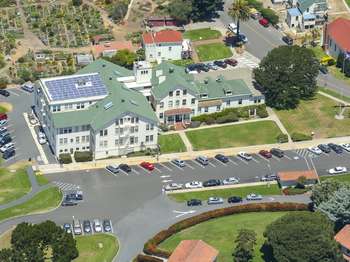Last updated: March 3, 2021
Place
11 - Great Meadow

WAYSIDE TITLE: The Great Meadow
PANEL LOCATION: The wayside faces north and is placed on a brick platform extending into the Great Meadow from the asphalt trail of the Great Meadow Loop. Accessible restrooms are further down the trail on the righthand side.
VIEW FROM WAYSIDE: The wayside faces the Great Meadow, a large grassy expanse dotted with a few palm trees. People and dogs often mill about on the meadow. Monterrey cypress line the distance, accompanied by the red roofs of lower Fort Mason's landmark buildings. The Golden Gate Bridge expands over the rooftops of San Francisco's buildings to your left. The Great Meadow Loop trail extends to either side of you, and also branches off into a larger extension of the loop trail directly behind you.
TEXT: Land of Many Uses. The open area before you has seen many historic events over the years. After the great 1906 San Francisco earthquake, the army pitched a tent camp that housed thousands of refugees. In 1915 the scene looked entirely different, as people from across the nation enjoyed the Panama Pacific International Exposition, a spectacular world's fair that spread west from here to the Presidio.
Following the fair, the army built over the area and by the end of World War 2, buildings and roads covered almost every inch of the present meadow. The palm trees you see today once stood beside MacArthur Avenue.
With the advent of the urban national parks movement, Fort Mason became part of the Golden Gate National Recreation Area in 1972. This site was again transformed as overgrown foundations and roads were replaced with lawns and paths. Re-named the "Great Meadow," the area is now open space for all to enjoy.
TEXT: How has a place in your community changed?
DESCRIPTION OF IMAGE #1: In the lower left corner, there is a photo, dated 1915, of a large walking promenade bordered by whimsical amusement-themed buildings, including a striped spire and a two-story depiction of a carnival-goer with a top hat and cymbal
CAPTION: The world's fair amusement area, known as the Joy Zone, spilled onto Fort Mason. The Zone included a five-acre model of the Grand Canyon near this spot.
DESCRIPTION OF IMAGE #2: An aerial photo of Fort Mason, dated 1940, is in the lower right corner. There is an orange circle with the text "You Are Here" indicates that you are currently in the lower left of this image, near the former site of large warehouses. The area is heavily developed, and lacks the open, green spaces that characterize Fort Mason today.
CAPTION: During World War 2, you would have seen MacArthur Avenue ahead of you. Barracks, mess halls, warehouses, offices, and other facilities packed both sides of the street. These buildings supported critical shipping of soldiers and supplies to the Pacific.
DESCRIPTION OF IMAGE #3: Dated 1906, this photograph shows lines of cloth tents pitched in an open field. People mill about these tents, and some of them wear suits and top hats.
CAPTION: This site was an emergency relief camp for San Franciscans after the 1906 earthquake and fire, including this temporary camp set up for Chinese refugees as they were pushed progressively away from the ashes of Chinatown. Their camp eventually ended up at the west side of the Presidio.
DIRECTIONS TO NEXT WAYSIDE: Follow the trail for 252 additional feet. Turn right at the fork and walk 222 feet, and you will reach the next wayside.
